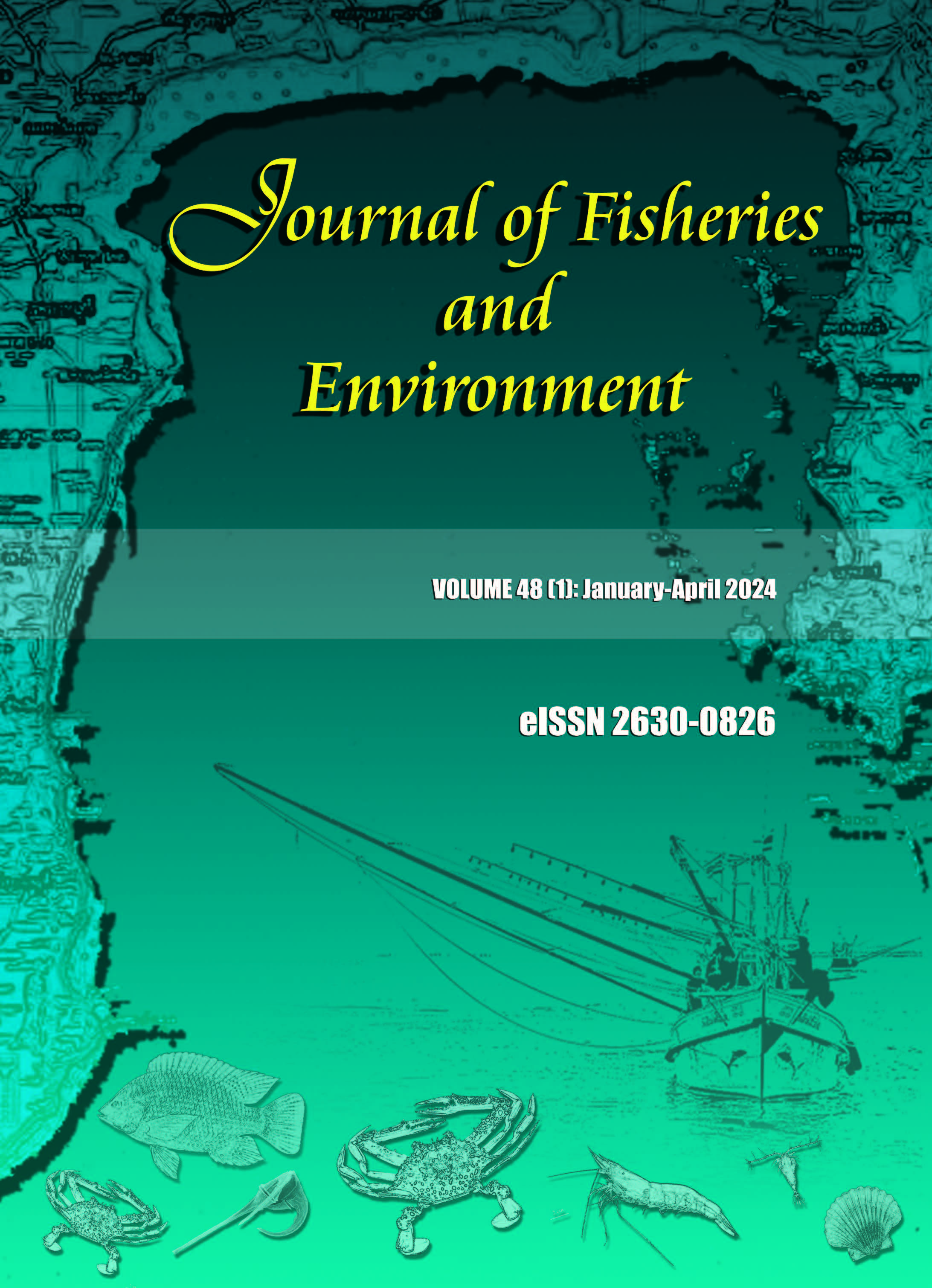Heavy Metal Accumulation in Lake Sediments in the Impact Zone of Trout Cage Farm
Main Article Content
Abstract
Chemical residues from aquaculture, especially heavy metals, are harmful to environment. The present study assessed the seasonal dynamics and potential toxic effects of heavy metal accumulation (Cr, Cu, Zn, and Pb) in lake sediments within the impact zone of the trout cage farm (Lake Ladoga, Russia). The tasks included the layer-by-layer analysis of total content of the heavy metals and their labile forms in sediment cores collected in the winter and autumn seasons. Four sites located directly next to the cages and three reference sites (150, 600 and 1000 m from the farm) were studied. Sediments cores collected using gravity corer were analyzed for total content analysis, where sediment samples were decomposed with strong acids (HClO4, HF, HCl, and HNO3), and the labile forms were extracted by ammonium acetate. The results showed that sediments under fish cages were significantly polluted by Zn and Cu especially towards the end of the active feeding period (autumn), thus potentially increasing sediment toxicity. Therefore, Zn and Cu can be utilized as geochemical markers for assessing the thickness of the accumulated contaminated sediment layer in the impact zone of cage farms. Pollution of the sediments by heavy metals is local and limited to the studied bay. Hence, there is no risk of secondary pollution of the water column according to the RAC index. However, the absolute content (mg·kg-1) of labile Zn is much higher under the cage than at reference sites.
Article Details

This work is licensed under a Creative Commons Attribution-NonCommercial-NoDerivatives 4.0 International License.
References
Bakhmet, I.N., T.Y. Kuchko and Y. Kuchko. 2017. Features of growing rainbow trout (Parasalmo mykiss) in the White Sea. Scientific notes of Petrozavodsk State University 6: 62–66. (in Russian)
Guzeva, A., Z. Slukovskii, V. Dauvalter and D. Denisov. 2021. Trace element fractions in sediments of urbanised lakes of the arctic zone of Russia. Environmental Monitoring and Assessment 193: 378. DOI: 10. 1007/s10661-021-09166-z.
Kaya, D. and S. Pulatsu. 2017. Sediment-focused environmental impact of rainbow trout (Oncorhynchus mykiss walbaum, 1792) cage farms: Almus reservoir (Tokat). Turkish Journal of Fisheries and Aquatic Sciences 17(2): 345–352.
Lall, S.P. and S.J. Kaushik. 2021. Nutrition and metabolism of minerals in fish. Animals 11(9): 2711. DOI: 10.3390/ani11092711.
Lapenkov, A., A. Guzeva, K. Zaripova and Z. Slukovskii. 2023. The seasonal dynamics of geochemical characteristics of sediments in the impact zone of the fish farm (Lake Ladoga, Russia). Aquaculture and Fisheries 8(6): 654–660.
Li, Y., Z. Duan, G. Liu, P. Kalla, D. Scheidt and Y. Cai. 2015. Evaluation of the possible sources and controlling factors of toxic metals/metalloids in the Florida Everglades and their potential risk of exposure. Environmental Science and Technology 49: 9714–9723.
Liang, P., S. Wu, J. Zhang, Y. Cao, S. Yu and M. Wong. 2016. The effects of mariculture on heavy metal distribution in sediments and cultured fish around the Pearl River Delta region, south China. Chemosphere 148: 171–177.
MacDonald, D., C. Ingersoll and T. Berger. 2000. Development and evaluation of consensus-based sediment quality guidelines for freshwater ecosystems. Archives of Environmental Contamination and Toxicology 39: 20–31.
Melo Júnior, H.D.N., F.J. de Paula Filho, J.M.C. Menezes, et al. 2023. Impacts of the residual trace metals of aquaculture in net cages on the quality of sediment. Life 13: 338. DOI: 10.3390/life13020338.
Müller, G. 1969. Index of geo-accumulation in sediments of the Rhine River. GeoJournal 2: 108–118.
Oliveira, K.F., L.D. Lacerda, T.F. Peres, R.V. Marins and J.A. Santos. 2017. The Fate of Cu, Zn and Mn in an intensive fish aquaculture (Tilapia - Oreochromis niloticus) in an artificial reservoir in Northeastern Brazil. Environmental Processes 4: 107–121.
Passos, E.A., J. Alves, C. Garcia and A. Costa. 2011. Metal fractionation in sediments of the Sergipe River, Northeast, Brazil. Journal of the Brazilian Chemical Society 22: 828–835.
Petrov, L.L., Y.N. Kornakov, L.A. Persikova and E.A. Anchutina. 1999. Reference samples of Lake Baikal bottom sediments - an essential part of regional collection of reference samples. International Journal of Environmental Analytical Chemistry 74(1–4): 275–288.
Ryzhkov, L.P., I.M. Dzyubuk, A.V. Gorokhov, L.P. Marchenko, N.V. Artem’eva, T.A. Ieshko, M.G. Ryabinkina and V.A. Radnaeva. 2011. The state of the aquatic environment and biota during operation of trout-breeding pond farms (Russian). Water Resources 38(2): 244–252. DOI: 10.1134/S0097807811020138.
Sapkota, A., A. Sapkota, K. Margaret, B. Janelle, M. Shawn, W. Polly and L. Robert. 2008. Aquaculture practices and potential human health risks: current knowledge and future priorities. Environment International 34: 1215–1226.
Slukovskii, Z. 2020. Background concentrations of heavy metals and other chemical elements in the sediments of small lakes in the south of Karelia, Russia. Vestnik MGTU 23: 80–92.
Varol, M. 2019. Impacts of cage fish farms in a large reservoir on water and sediment chemistry. Environmental Pollution 252: 1448–1454.
Xie, Q., L. Qian, S. Liu, Y. Wang, Y. Zhang and D. Wang. 2020. Assessment of long-term effects from cage culture practices on heavy metal accumulation in sediment and fish. Ecotoxicology and Environmental Safety 194: 110433. DOI: 10.1016/j.ecoenv.2020.110433.
Yu, T., Y. Zhang, X. Hu and W. Meng. 2012. Distribution and bioaccumulation of heavy metals in aquatic organisms of different trophic levels and potential health risk assessment from Taihu lake, China. Ecotoxicology and Environmental Safety 81: 55–64.
Zhang, Z., Y. Lu, H.M. Li, Y. Tu, B. Liu and Z. Yang. 2018. Assessment of heavy metal contamination, distribution and source identification in the sediments from the Zijiang River, China. Science Total Environment 645: 235–243.


